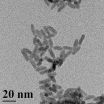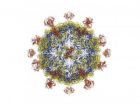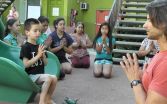(Press-News.org) BUFFALO, N.Y. -- Quantum dots made from cadmium and selenium degrade in soil, unleashing toxic cadmium and selenium ions into their surroundings, a University at Buffalo study has found.
The research, accepted for publication in the journal Environmental Science and Technology, demonstrates the importance of learning more about how quantum dots -- and other nanomaterials -- interact with the environment after disposal, said Diana Aga, the chemistry professor who led the study.
Quantum dots are semiconductor nanocrystals with diameters of about 2 to 100 nanometers. Though quantum dots are not yet commonly used in consumer products, scientists are exploring the particles' applications in technologies ranging from solar panels to biomedical imaging.
"Quantum dots are not yet used widely, but they have a lot of potential and we can anticipate that the use of this nanomaterial will increase," said Aga, who presented the findings in late June at a National Science Foundation-funded workshop on nanomaterials in the environment. "We can also anticipate that their occurrence in the environment will also increase, and we need to be proactive and learn more about whether these materials will be a problem when they enter the environment."
"We can conclude from our research that there is potential for some negative impacts, since the quantum dots biodegrade. But there is also a possibility to modify the chemistry, the surface of the nanomaterials, to prevent degradation in the future," she said.
Aga's research into the afterlife of quantum dots is funded by a $400,000 Environmental Protection Agency grant to investigate the environmental transport, biodegradation and bioaccumulation of quantum dots and oxide nanoparticles.
Her collaborators on the new study in Environmental Science and Technology include PhD student Divina Navarro, Assistant Professor Sarbajit Banerjee and Associate Professor David Watson, all of the UB Department of Chemistry.
Working in the laboratory, the team tested two kinds of quantum dots: Cadmium selenide quantum dots, and cadmium-selenide quantum dots with a protective, zinc-sulfide shell. Though the shelled quantum dots are known in scientific literature to be more stable, Aga's team found that both varieties of quantum dot leaked toxic elements within 15 days of entering soil.
In a related experiment designed to predict the likelihood that discarded quantum dots would leach into groundwater, the scientists placed a sample of each type of quantum dot at the top of a narrow soil column. The researchers then added calcium chloride solution to mimic rain.
What they observed: Almost all the cadmium and selenium detected in each of the two columns -- more than 90 percent of that in the column holding unshelled quantum dots, and more than 70 percent of that in the column holding shelled quantum dots - -remained in the top 1.5 centimeters of the soil.
But how the nanomaterials moved depended on what else was in the soil. When the team added ethylenediaminetetraacetic acid (EDTA) to test columns instead of calcium chloride, the quantum dots traveled through the soil more quickly. EDTA is a chelating agent, similar to the citric acid often found in soaps and laundry detergents.
The data suggest that under normal circumstances, quantum dots resting in top soil are unlikely to burrow their way down into underground water tables, unless chelating agents such as EDTA are introduced on purpose, or naturally-occurring organic acids (such as plant exudates) are present.
Aga said that even if the quantum dots remain in top soil, without contaminating underground aquifers, the particles' degradation still poses a risk to the environment.
In a separate study submitted for publication in a different journal, she and her colleagues tested the reaction of Arabidopsis plants to quantum dots with zinc sulfide shells. The team found that while the plants did not absorb the nanocrystals into their root systems, the plants still displayed a typical phytotoxic reaction upon coming into contact with the foreign matter; in other words, the plants treated the quantum dots as a poison.
INFORMATION:
The University at Buffalo is a premier research-intensive public university, a flagship institution in the State University of New York system and its largest and most comprehensive campus. UB's more than 28,000 students pursue their academic interests through more than 300 undergraduate, graduate and professional degree programs. Founded in 1846, the University at Buffalo is a member of the Association of American Universities.
Cadmium selenide quantum dots degrade in soil, releasing their toxic guts, study finds
2011-07-19
ELSE PRESS RELEASES FROM THIS DATE:
Attorney Howard H. Collens of Galloway and Collens, PLLC Speaks at Institute for Paralegal Education Training Seminar
2011-07-19
Howard H. Collens, attorney at the probate and estate planning law firm of Galloway and Collens, PLLC, spoke at a professional training seminar on The Probate Process From Start to Finish for Paralegals, sponsored by the Institute for Paralegal Education (IPE).
The seminar, which took place on June 7, 2011, aimed to increase the understanding and effectiveness of paralegals, legal assistants and legal secretaries during the legal process which may be required after a person dies. Howard H. Collens spoke about topics related to the probate process including the ethical ...
Juvenile diarrhea virus analyzed
2011-07-19
HOUSTON -- (July 18, 2011) -- Rice University scientists have defined the structure -- down to the atomic level -- of a virus that causes juvenile diarrhea. The research may help direct efforts to develop medications that block the virus before it becomes infectious.
The new paper by Professor Yizhi Jane Tao, postdoctoral researcher Jinhui Dong and their colleagues was published in today's online edition of the Proceedings of the National Academy of Sciences.
Tao's Rice lab specializes in gleaning fine details of viral structures through X-ray crystallography and computer ...
Registration Now Open for Nicaragua's Premier Investment Forum
2011-07-19
PRONicaragua recently announced the organization of the premier investment forum titled Nicaragua, Let's Grow Together!, which will showcase the country's sustainable growth in various economic sectors and its competitive advantages as an attractive destination for foreign direct investment (FDI).
The event will take place on August 16th and 17th in Managua, Nicaragua, and will focus on specialized sectors such as apparel, footwear, food processing and manufacturing, as well as world-class bilingual business process outsourcing (BPO) services. Participants will be coming ...
IBD, LCPD health research in 'Westie' dogs may hold answers to similar human diseases
2011-07-19
The Westie Foundation of America (WFA) announced
today preliminary findings in two major studies involving the health of West Highland White Terriers also
known as Westies. Findings in these and other studies of Westies and other dogs
may hold answers for similar human conditions like Inflammatory Bowel Disease (IBD). The studies are
jointly funded by the WFA and the AKC Canine Health Foundation (CHF).
In one study, researchers are looking at the role of a mucosal gene driving inflammation Canine IBD, a
chronic intestinal disorder that creates a bacterial-driven ...
Decisions, decisions, decisions ...
2011-07-19
We all make numerous decisions everyday; unconsciously or consciously, sometimes doing it automatically with little effort or thinking and yet, at other times, we agonize for hours over another. Why do we make these choices – be it from deciding what to have for lunch or whether to say yes to that job offer halfway round the world. Sometimes we make choices on our own, and at other times, the choice is made for us. Exercising control (by making choices) is adaptive and now, a new study, which will be published in an upcoming issue of Psychological Science, a journal of ...
Domestic Violence Charity Announces Fat Burn America Tour: 100 Cities in 100 Days
2011-07-19
What does a passionate founder of a domestic violence charity do when he wants to raise awareness and promote a daily fitness program? Rich Tola, Founder and Chairman of the yoga-inspired nonprofit, The Boulevard Zen Foundation, would say "We're going on a 30,000 mile fundraiser, visiting all 50 states in 100 days. That's 100 cities in 100 days, producing trivia-filled travelogue videos including fat burning workouts that are based on yoga". Ambitious? Yes. Impossible? "Certainly not," says the former Wall Streeter turned actor-filmmaker whose film, ...
Key metabolic pathway implicated in intractable form of breast cancer
2011-07-19
FINDINGS: Using a new in vivo screening system, Whitehead Institute researchers have identified a protein in a key metabolic pathway that is essential in estrogen receptor (ER)-negative breast cancer. When the expression of the gene that codes for this protein—phosphoglycerate dehydrogenase or PHGDH—is suppressed in tumors and cell lines with an overabundance of the protein, the rate of cellular growth declines markedly.
RELEVANCE: PHGDH is overexpressed in approximately 70% of ER-negative breast cancer patients. Patients with ER-negative disease respond poorly to treatment ...
Penn researchers find neural signature of 'mental time travel'
2011-07-19
PHILADELPHIA — Almost everyone has experienced one memory triggering another, but explanations for that phenomenon have proved elusive. Now, University of Pennsylvania researchers have provided the first neurobiological evidence that memories formed in the same context become linked, the foundation of the theory of episodic memory.
The research was conducted by professor Michael Kahana of the Department of Psychology in the School of Arts and Sciences and graduate student Jeremy R. Manning, of the Neuroscience Graduate Group in Penn's Perelman School of Medicine. They ...
Single traumatic brain injury may prompt long-term neurodegeneration
2011-07-19
PHILADELPHIA - Years after a single traumatic brain injury (TBI), survivors still show changes in their brains. In a new study, researchers from the Perelman School of Medicine at the University of Pennsylvania suggest that Alzheimer's disease-like neurodegeneration may be initiated or accelerated following a single traumatic brain injury, even in young adults.
Over 1.7 million Americans suffer a traumatic brain injury each year, and beyond the immediate effects, growing evidence demonstrates that a single TBI may initiate long-term processes that further damage the brain. ...
USC research: Cancer cells and stem cells share same origin
2011-07-19
Oncogenes are generally thought to be genes that, when mutated, change healthy cells into cancerous tumor cells. Scientists at the Keck School of Medicine of the University of Southern California (USC) have proven that those genes also can change normal cells into stem-like cells, paving the way to a safer and more practical approach to treating diseases like multiple sclerosis and cancer with stem cell therapy.
"The reality may be more complicated than people think," said Jiang F. Zhong, Ph.D., assistant professor of pathology at the Keck School. "What is a stem cell ...


